Edition XX (Drop)
back to HIFIMAN
back to measurements
home
published: Jan-24-2019, updated: Nov-24-2019
NO SMOOTHING is applied to the shown plots. Most measurement sites have some smoothing applied which ‘irons flat’ sharp peaks and ‘wiggles’. I do not use smoothing because some info about sound quality is lost when plots are smoothed.
Aside from a small correction of the microphone itself also some correction in the lowest frequencies is applied to the plots to compensate for the perceived loss of bass when using headphones. This is described HERE in more detail.
A ‘horizontal‘ frequency response curve on the shown frequency response plots on this website thus indicates a perceived ‘flat’ tonal signature.
ALL measurements are made with a good SEAL on a flatbed measurement rig.
The shape of your head, bone structure, pad size, pad ‘softness, (compliance), hair or no hair and or wearing glasses may (drastically) change the frequency response of some headphones, so… your personal experience may differ substantially from these plots.
Frequency response (tonal balance) is the most sound-determining aspect of headphones. A horizontal line shows audible neutral response in the plots on this website. Deviations in different severities at different frequency bands have an effect on the sound character.
The bigger the deviation the stronger the effect.
Below an aid to help determining the sound character of headphones with relation to the frequency response.

HIFIMAN Edition XX (Massdrop)

The HIFIMAN Edition XX is a planar magnetic over-ear headphone intended to be driven directly from portable equipment. Drop sells/sold this for around $600.-
Because it has a very low impedance (20Ω) this headphone is designed to be driven directly from portable equipment. It isn’t really suited for commuting etc.
The ‘portable’ part here is for people who want to enjoy high quality music when at home or in a hotel or such. As the headphone does not fold flat, like the Edition Xv2, it will take up quite some space in the luggage.
All you need is a high quality Digital Audio Player which connects directly or with a desktop or portable amp.
The earpads are VERY large and very comfortable but sits on the head quite differently from most other headphones. The headphone is not lightweight but still feels quite light on the head. This is a very comfortable headphone.
The headband is bulkier than that of the Edition Xv2. To pull the cups down quite a bit of force is needed. As well as when rotating ad adjusting the cups. I expect this to become easier over time.
The cable is clearly intended for portable usage being just 1.5m long and having an angled 3.5mm TRS jack. The cable itself is supple and has a matte gold color silicone sleeve. I see no reason to replace it unless you want a longer cable or straight plug.
Everyone around you can hear what you are playing and you can hear all ambient noises unattenuated. It is as ‘open’ as it gets.
specifications:
Type: Over ear, open
Usage: Home
Driver type: planar magnetic
Pads: replaceable, slanted hybrid pleather/polyester cloth
Internal pad dimensions: Height 85mm , width 50mm (egg shaped) depth: 20mm front, 30mm back
Collapsible: No.
Headphone connector: 3.5mm TRS (marked L and R)
Cable entry: double sided
Cable: replaceable, 1.5m with gold plated angled 3.5 mm TRS plug
+ gold plated 6.3 mm adapter.
Driver size: 70 x 100 mm (magnet array is smaller)
Nom. power rating: (estimated 1W)
Max. voltage: (estimated 5V)
Max. current: (estimated 0.25A = 250mA)
Max. S.P.L.: (estimated 124dB)
Impedance: 20Ω
Efficiency: 93dB @ 1mW
Sensitivity: 110dB @ 1V
Weight: 430 g. (without cable)
Colour: black
Clamping force: low/medium
Accessories: 6.3mm adapter
Sound description:
The sound signature of the Edition XX is very realistic and dynamic and quite similar to that of the Edition Xv2 and Ananda.
Perhaps leaning somewhat to bass-lean side of things for some. Certainly not basshead material but also not bass-shy. It just slightly lacks in ‘grunt’ but sub-bass is still heard and impresses if recorded loud enough.
The mids are very realistic and instruments and voices do not sound colored. Maybe a tad ‘forward’ and ‘open’ sounding.
The treble part is where the Edition XX is not as good as the midrange. On some recordings there is a sharp ‘edge’ to the sound which distracts from the rest of the sound.
There is no sibilance nor ‘harsh’ treble though. The treble in general is at the proper level and sounds smooth on classical recordings. On some recordings the headphone just has a ‘sharp’ but not piercing character.
Fortunately there is a solution for this which makes the treble nice and smooth sounding and turns this headphone into a very nice sounding headphone.
measurements:
Below the frequency response of the Edition X (Left, Right)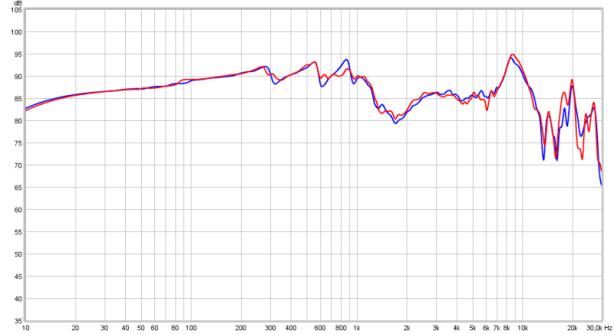 The channel balance is quite good as with most HIFIMAN headphones. The tonal balance is ‘flat’ as in neutral. It is perhaps slightly lacking in ‘grunt’. The Edition XX is tight in the bass and very realistic.
The channel balance is quite good as with most HIFIMAN headphones. The tonal balance is ‘flat’ as in neutral. It is perhaps slightly lacking in ‘grunt’. The Edition XX is tight in the bass and very realistic.
The mids sound dynamic and realistic. The 5dB dip from 2kHz to 5kHz lowers the sense of ‘presence/clarity’ of voices a tiny bit which makes the mids just slightly and pleasantly ‘laid back’. This is partly obscured by the treble peak.
It has a similar ‘8kHz peak’ as the Edition X v2, Ananda and HE1000.
That peak is audible as a sharp ‘edge’ in the music. The same (but slightly less objectionable) can be heard in most HIFIMAN headphones. It is also the reason why these headphones sound ‘highly detailed’ and ‘fragile’.
Treble extension is excellent and most likely extends beyond 30kHz.
This headphone looks the most like the Edition X v2, Ananda and the HE 1000, however, the Edition XX is far less expensive.
The HE1000 must be connected to a good desktop amp as well but does sound smoother and more refined.
Because these headphones have so much in common a comparison between these 4 models is shown below, HE-1000, Edition Xv2, Ananda and Edition XX
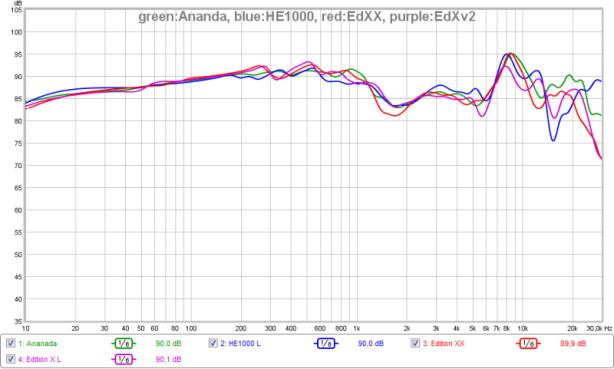 These headphones have a LOT more in common than just looks. 1/6 octave smoothing is applied so the tonal balance differences become more obvious.
These headphones have a LOT more in common than just looks. 1/6 octave smoothing is applied so the tonal balance differences become more obvious.
Differences are showing above 10kHz. These differences can be up to 10dB so there are measurable differences in the treble. This is where they differ the most in sound as well.
The Ananda and Edition XX aren’t very far apart in SQ. The Ananda is sonewhat airier.
There are other differences well over 2 dB at various frequency bands so even though the plots show the overall tonal balance is comparable there certainly are audible differences between these models.
Below the distortion measurements of the Edition XX (left channel)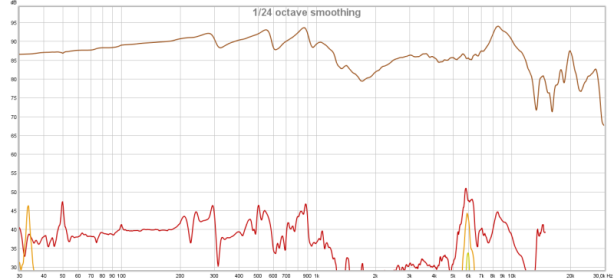
Below the distortion plot but displayed in percentages. The distortion levels are VERY low. Below 0.5% in the lows. Note the higher 2nd harmonic distortion shown in the plot is lower than shown. This is merely showing the lower limit of the test jig.
The distortion levels are VERY low. Below 0.5% in the lows. Note the higher 2nd harmonic distortion shown in the plot is lower than shown. This is merely showing the lower limit of the test jig.
The Distortion spike around 6kHz is real though and reaches an audible 2%. This and the treble peak are responsible for the sharpish ‘edge’.
Below the CSD of the Edition XX. (Left and Right are superimposed) Yes, this looks quite messy. Even to the point you start to wonder if this would be audible in a negative way. It looks as though the membrane loves to vibrate at a lot of frequencies and simply has so much fun moving it doesn’t want to stop. At 5kHz there is a resonance showing. There is some short lived ringing between 16 and 20kHz.
Yes, this looks quite messy. Even to the point you start to wonder if this would be audible in a negative way. It looks as though the membrane loves to vibrate at a lot of frequencies and simply has so much fun moving it doesn’t want to stop. At 5kHz there is a resonance showing. There is some short lived ringing between 16 and 20kHz.
output resistance / damping-factor
As this is a planar magnetic headphone its impedance is as good as ruler flat so a higher output resistance amplifier will have no consequences for the frequency response/tonal balance/damping. Driven from 0.5Ω and 120Ω amplifier. The traces are overlaid to show tonal balance differences but in reality via 120Ω it will play 16.5dB softer.
The wiggles at 50Hz and 100Hz is mains hum.
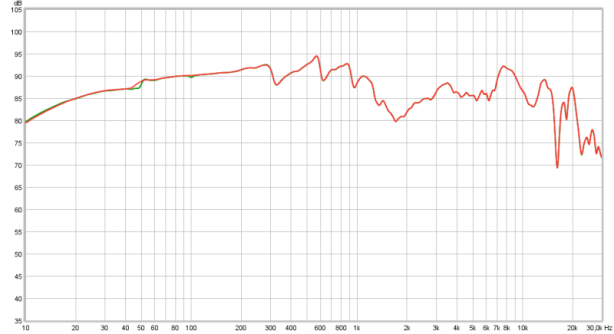
Below the spectrum plot of the Edition XX. 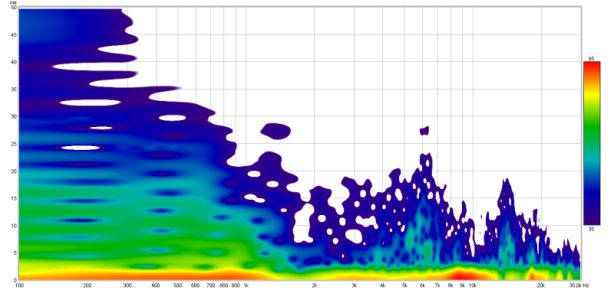
Well, this looks messy as well to the point where one wonders how audible this all is. The observant folks amongst us will notice that the green parts are down -20dB and the blue parts are already -40dB down. This means that the signal doesn’t die out as fast as with dynamic headphones. This behavior is seen with a lot of planar magnetic headphones.
In some circles people find planar headphones (including electrostats) have compressed dynamics in the sense that the decay of instruments isn’t as good as that of dynamic headphones. Well.. this could be the smoking gun for that theses.
It looks like these large membranes that have little to no acoustical/mechanical damping simply LIKE to vibrate at almost all frequencies once a signal has stopped.
The step response (Left, Right) below shows the sub-bass is just slightly rolled-off. The resonances are short lived and not high in amplitude. The impulse response is just slightly lower than ideal and shows excellent response with a light emphasis in the lower treble/upper mids. It thus sounds very clear and articulated. You can still see some medium frequency wiggles in a low amplitude on the horizontal trace which show the lingering discussed above.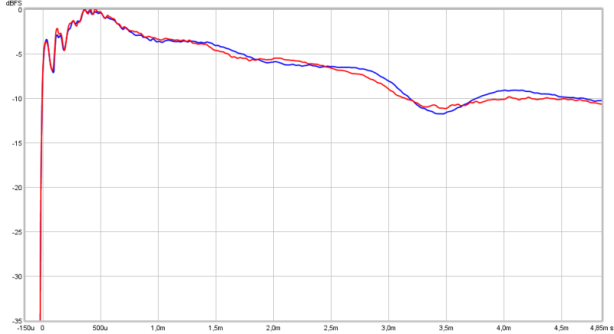
The treble peak is kind of distracting from the finer qualities of this headphone. It is safe to say that without this peak the sound would be very good, realistic and very smooth in the treble. Of course this peak can be addressed using a small passive filter. This filter has to come in the headphone cable or should I say come in front of it in a small extension cord. Those that find the Edition XX too ‘sharp’ sounding should really consider having such an extension cord built. A filter can be ordered here
Below the schematic of the filter is shown. There are 2 filters shown. The one on the left is as used and shown in the graphs. The one on the right completely removes the treble peak and may be better for very treble sensitive folks. The filter on the left lowers the peak to more sensible levels and leaves a tiny bit there so it still sounds airy and sparkly yet smooth and not exaggerated.
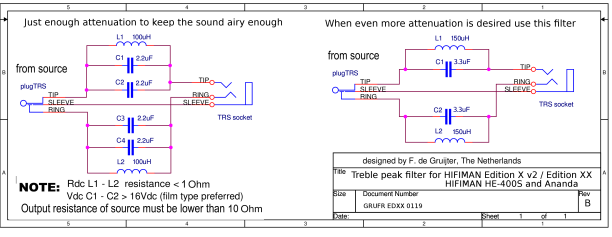
Below the effect of the filter is clearly shown. Stock, left filter schematic.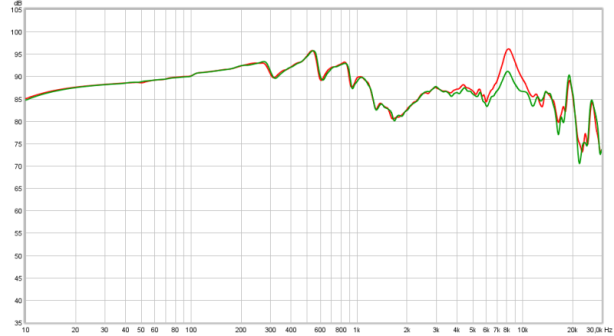
The treble peak is lowered by a quite audible 5dB.
Below the more rigorous filter version on the right.
Below the step response is shown with and without the (left)filter. Here too a substantial lowering of the 6kHz resonance is seen.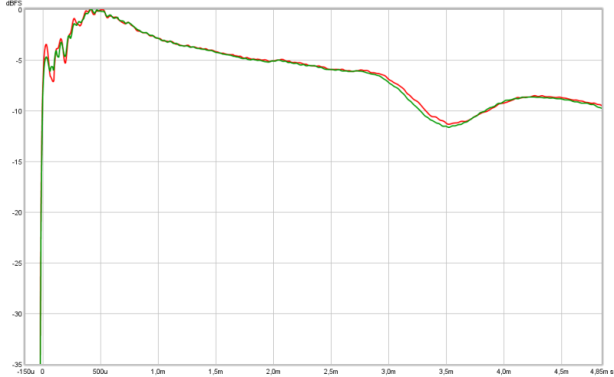
Finally the CSD also shows improvements. It also shows the resonance around 6kHz is shortened.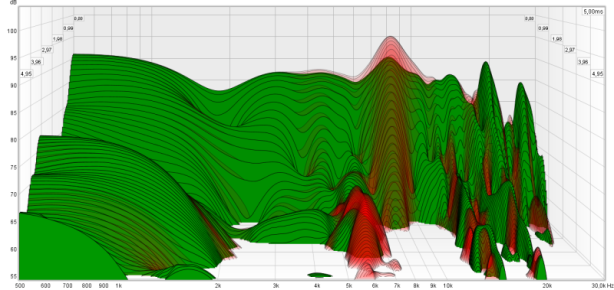
This simple filter turns the Edition XX in a great sounding headphone with a smooth yet articulated treble. Below the filter parts for 1 channel next to a 6.3mm connector.
It is not easy to fit 2 filters in there but it is possible. (the filters have some isolation tape around them when mounted).
 Below a practical filter ‘extension cord’. As the filter parts are in the plug the socket where the headphone plugs in can also be 3.5mm TRS.
Below a practical filter ‘extension cord’. As the filter parts are in the plug the socket where the headphone plugs in can also be 3.5mm TRS.

summary
Fit and finish, comfort, weight (for a planar) are very good. It is a bit on the large side from top to bottom. Not everyone will like those very large pads and how they sit on the jaws.
Adjusting the headband and cup positioning is stiff . One set correctly it will stay put though.
The sound signature is very realistic and dynamic. Perhaps leaning somewhat to bass-lean side of things for some. Slightly lacks in ‘grunt’ but sub-bass is still heard and impresses if recorded loud enough. The treble peak is the weak spot of this headphone. When you are not bothered by it than this is great. For treble sensitive folks, like me, it is a bit too much. This makes the headphone a tad ‘sharp’ sounding. Fortunately there is a solution for this which makes the treble nice and smooth sounding.
A very, very nice sounding headphone. The special Drop pricing makes this headphone an excellent buy. Of course this headphone can’t be bought in the stores but for them a Edition Xv2 or Ananda is a reasonable alternative.
For about the same price there is also the Sundara but this one has a different driver and looks. To me the Sundara is slightly coarser sounding though.
The HE1000 has a similar tonal balance but is a bit airier sounding and a more refined.
It is great that the Edition XX can be driven directly from portable equipment. As the efficiency is not very high a decent DAP or portable amplifier is still recommended to make use of the huge dynamic range.
